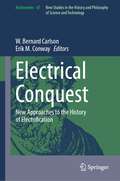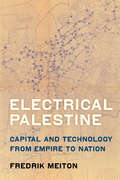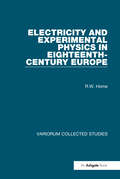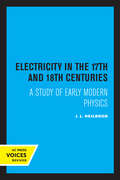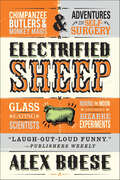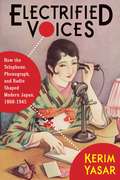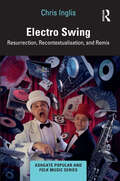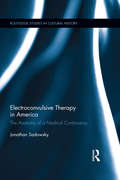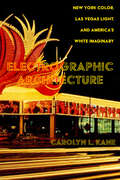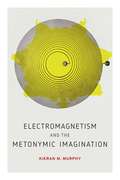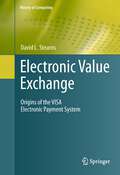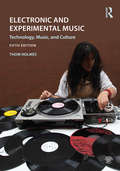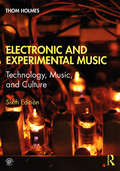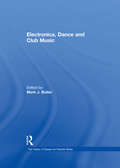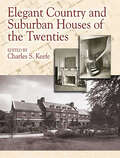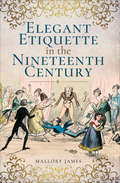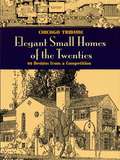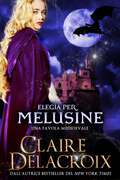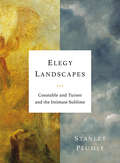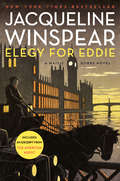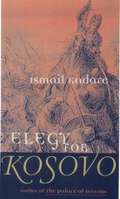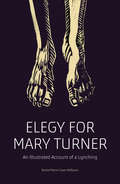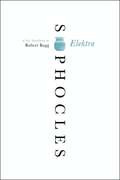- Table View
- List View
Electrical Conquest: New Approaches to the History of Electrification (Archimedes #67)
by W. Bernard Carlson Erik M. ConwayThis book, drawing on fresh scholarship, investigates electrification in new places and across different time periods. While much of our understanding of electrification as a historical process is based on the seminal work done by Thomas P. Hughes in Networks of Power (1983), the scholars in this volume expand and revise Hughes’ systems approach to suggest that electrification is a heterogeneous and contingent process. Moreover, the contributors suggest that the conquest of the world by electricity remains incomplete despite more than a century elapsing. Above all, though, this book provides context for thinking about what lies ahead as humans continue their conquest of the earth through electricity. As we become increasingly dependent on electricity to power our lights, heat and cool our homes, turn the wheels of industry, and keep our information systems humming, so we are ever more vulnerable when the grid runs into trouble.Chapter "Surveying the Landscape: The Oil Industry and Alternative Energy in the 1970s" is available open access under a Creative Commons Attribution 4.0 International License via link.springer.com.
Electrical Palestine: Capital and Technology from Empire to Nation
by Fredrik MeitonElectricity is an integral part of everyday life—so integral that we rarely think of it as political. In Electrical Palestine, Fredrik Meiton illustrates how political power, just like electrical power, moves through physical materials whose properties govern its flow. At the dawn of the Arab-Israeli conflict, both kinds of power were circulated through the electric grid that was built by the Zionist engineer Pinhas Rutenberg in the period of British rule from 1917 to 1948. Drawing on new sources in Arabic, Hebrew, and several European languages, Electrical Palestine charts a story of rapid and uneven development that was greatly influenced by the electric grid and set the stage for the conflict between Arabs and Jews. Electrification, Meiton shows, was a critical element of Zionist state building. The outcome in 1948, therefore, of Jewish statehood and Palestinian statelessness was the result of a logic that was profoundly conditioned by the power system, a logic that has continued to shape the area until today.
Electricity and Experimental Physics in Eighteenth-Century Europe (Variorum Collected Studies)
by R.W. HomeAt the beginning of the 18th century there was no science of physics as we recognise it today; by the early years of the nineteenth century, there was. The articles in this volume are concerned with the process by which this came about. They focus, in particular, on the rise of experimental physics and the interactions between experiment, theory and mathematics in the study of electricity and, to a lesser extent, magnetism and physical optics during this period. Along the way, they provide a significant reassessment of Isaac Newton’s influence on the science of his successors. A further recurring theme is the process by which ideas were disseminated within the expanding scientific community of the day, and the manner of their reception, often in a form somewhat different from that envisaged by their first inventors, as Professor Home argues took place in the case of Franklin. The social and intellectual context of the ’scientist’, indeed, is the specific subject of several essays, dealing not only with England and France, but also offering new insights into the position of science in 18th-century Russia. Au début du 18e s., la science physique telle que nous l’entendons de nos jours, n’existait pas; dès les premières années du 19e s., cela n’était plus le cas. Les articles contenus dans ce volume s’intéressent au procédé qui a provoqué ce changement. Ils s’attachent plus particulièrement à la montée de la physique expérimentale et à l’interaction entre expérience, théorie et mathématiques en ce qui concerne l’étude de l’électricité et, dans une moindre mesure, celle du magnétisme et de l’optique physique durant cette période. Ce faisant, les études fournissent une ré-évaluation significative de l’influence d’Isaac Newton sur la science de ses successeurs. Un autre thème est celui du processus par lequel les idées étaient disséminées à l’époque au sein d’une communauté scientifique en pleine expans
Electricity in the 17th and 18th Centuries: A Study of Early Modern Physics
by J. L. HeilbronThis title is part of UC Press's Voices Revived program, which commemorates University of California Press’s mission to seek out and cultivate the brightest minds and give them voice, reach, and impact. Drawing on a backlist dating to 1893, Voices Revived makes high-quality, peer-reviewed scholarship accessible once again using print-on-demand technology. This title was originally published in 1979.
Electrified Sheep: Glass-eating Scientists, Nuking The Moon, And More Bizarre Experiments
by Alex Boese"Perfect summertime reading—preferably with a friend nearby who can be constantly interrupted with unsettling facts." —Daily Mail (UK )Benjamin Franklin was a pioneering scientist, leader of the Enlightenment, and a founding father of the United States. But perhaps less well known is that he was also the first person to use mouth-to-mouth resuscitation on an electric-shock victim. Odder still, it was actually mouth-to-beak resuscitation on a hen that he himself had shocked. Welcome to some of the weirdest and most wonderful experiments ever conducted in the name of science. Filled with stories of science gone strange, Electrified Sheep is packed with eccentric characters, irrational obsessions, and extreme experiments. Watch as scientists attempt to nuke the moon, wince at the doctor who performs a self-appendectomy, and catch the faint whiff of singed wool from an electrified sheep.
Electrified Voices: How the Telephone, Phonograph, and Radio Shaped Modern Japan, 1868–1945 (Studies of the Weatherhead East Asian Institute, Columbia University)
by Kerim YasarLong before karaoke’s ubiquity and the rise of global brands such as Sony, Japan was a place where new audio technologies found eager users and contributed to new cultural forms. In Electrified Voices, Kerim Yasar traces the origins of the modern soundscape, showing how the revolutionary nature of sound technology and the rise of a new auditory culture played an essential role in the formation of Japanese modernity.A far-reaching cultural history of the telegraph, telephone, phonograph, radio, and early sound film in Japan, Electrified Voices shows how these technologies reshaped the production of culture. Audio technologies upended the status of the written word as the only source of prestige while revivifying traditional forms of orality. The ability to reproduce and transmit sound, freeing it from the constraints of time and space, had profound consequences on late nineteenth-century language reform; twentieth-century literary, musical, and cinematic practices; the rise of militarism and nationalism in the 1920s and 30s; and the transition to the postwar period inaugurated by Emperor Hirohito’s declaration of unconditional surrender to Allied forces—a declaration that was recorded on a gramophone record and broadcast throughout the defeated Japanese empire. The first cultural history in English of auditory technologies in modern Japan, Electrified Voices enriches our understanding of Japanese modernity and offers a major contribution to sound studies and global media history.
Electro Swing: Resurrection, Recontextualisation, and Remix (Ashgate Popular and Folk Music Series)
by Chris InglisElectro swing is a relatively recent musical style and scene which combines the music of the swing era with that of the age of electronic dance music. Chris Inglis considers key questions about electro swing’s place in contemporary society, including what it may mean for a contemporary genre to be so reliant upon the influences of the past; the different ways in which jazz may be presented to a modern audience; how one may go about defining jazz in todays postmodern world; and how this emergent genre may be analysed in terms of the wider issues of race and class consumption.
Electroconvulsive Therapy in America: The Anatomy of a Medical Controversy (Routledge Studies in Cultural History #49)
by Jonathan SadowskyElectroconvulsive Therapy is widely demonized or idealized. Some detractors consider its very use to be a human rights violation, while some promoters depict it as a miracle, the "penicillin of psychiatry." This book traces the American history of one of the most controversial procedures in medicine, and seeks to provide an explanation of why ECT has been so controversial, juxtaposing evidence from clinical science, personal memoir, and popular culture. Contextualizing the controversies about ECT, instead of simply engaging in them, makes the history of ECT more richly revealing of wider changes in culture and medicine. It shows that the application of electricity to the brain to treat illness is not only a physiological event, but also one embedded in culturally patterned beliefs about the human body, the meaning of sickness, and medical authority.
Electrographic Architecture: New York Color, Las Vegas Light, and America's White Imaginary
by Prof. Carolyn L. KaneBridging histories of technology, media studies, and aesthetics, Electrographic Architecture forges a critical narrative of the ways in which illuminated light and color have played key roles in the formation of America's white imaginary. Carolyn L. Kane charts the rise of the country's urban advertisements, light empires, and neoclassical buildings in the early twentieth century; the midcentury construction of polychromatic electrographic spectacles; and their eclipse by informatically intense, invisible algorithms at the dawn of the new millennium. Drawing on archival research, interviews, and visual analysis, Electrographic Architecture shows how the development of America's electrographic surround runs parallel to a new paradigm of power, property, and possession.
Electromagnetism and the Metonymic Imagination (AnthropoScene #4)
by Kieran M. MurphyHow does the imagination work? How can it lead to both reverie and scientific insight? In this book, Kieran M. Murphy sheds new light on these perennial questions by showing how they have been closely tied to the history of electromagnetism.The discovery in 1820 of a mysterious relationship between electricity and magnetism led not only to technological inventions—such as the dynamo and telegraph, which ushered in the “electric age”—but also to a profound reconceptualization of nature and the role the imagination plays in it. From the literary experiments of Edgar Allan Poe, Honoré de Balzac, Villiers de l’Isle-Adam, and André Breton to the creative leaps of Michael Faraday and Albert Einstein, Murphy illuminates how electromagnetism legitimized imaginative modes of reasoning based on a more acute sense of interconnection and a renewed interest in how metonymic relations could reveal the order of things.Murphy organizes his study around real and imagined electromagnetic devices, ranging from Faraday’s world-changing induction experiment to new types of chains and automata, in order to demonstrate how they provided a material foundation for rethinking the nature of difference and relation in physical and metaphysical explorations of the world, human relationships, language, and binaries such as life and death. This overlooked exchange between science and literature brings a fresh perspective to the critical debates that shaped the nineteenth century.Extensively researched and convincingly argued, this pathbreaking book addresses a significant lacuna in modern literary criticism and deepens our understanding of both the history of literature and the history of scientific thinking.
Electromagnetism and the Metonymic Imagination (AnthropoScene: The SLSA Book Series #4)
by Kieran M. MurphyHow does the imagination work? How can it lead to both reverie and scientific insight? In this book, Kieran M. Murphy sheds new light on these perennial questions by showing how they have been closely tied to the history of electromagnetism.The discovery in 1820 of a mysterious relationship between electricity and magnetism led not only to technological inventions—such as the dynamo and telegraph, which ushered in the "electric age"—but also to a profound reconceptualization of nature and the role the imagination plays in it. From the literary experiments of Edgar Allan Poe, Honoré de Balzac, Villiers de l’Isle-Adam, and André Breton to the creative leaps of Michael Faraday and Albert Einstein, Murphy illuminates how electromagnetism legitimized imaginative modes of reasoning based on a more acute sense of interconnection and a renewed interest in how metonymic relations could reveal the order of things.Murphy organizes his study around real and imagined electromagnetic devices, ranging from Faraday’s world-changing induction experiment to new types of chains and automata, in order to demonstrate how they provided a material foundation for rethinking the nature of difference and relation in physical and metaphysical explorations of the world, human relationships, language, and binaries such as life and death. This overlooked exchange between science and literature brings a fresh perspective to the critical debates that shaped the nineteenth century.Extensively researched and convincingly argued, this pathbreaking book addresses a significant lacuna in modern literary criticism and deepens our understanding of both the history of literature and the history of scientific thinking.
Electronic Value Exchange
by David L. StearnsElectronic Value Exchange examines in detail the transformation of the VISA electronic payment system from a collection of non-integrated, localized, paper-based bank credit card programs into the cooperative, global, electronic value exchange network it is today. Topics and features: provides a history of the VISA system from the mid-1960s to the early 1980s; presents a historical narrative based on research gathered from personal documents and interviews with key actors; investigates, for the first time, both the technological and social infrastructures necessary for the VISA system to operate; supplies a detailed case study, highlighting the mutual shaping of technology and social relations, and the influence that earlier information processing practices have on the way firms adopt computers and telecommunications; examines how "gateways" in transactional networks can reinforce or undermine established social boundaries, and reviews the establishment of trust in new payment devices.
Electronic and Experimental Music: Technology, Music, and Culture (Media And Popular Culture Ser.)
by Thom HolmesElectronic and Experimental Music: Technology, Music, and Culture provides a comprehensive history of electronic music, covering key composers, genres, and techniques used in analog and digital synthesis. This textbook has been extensively revised with the needs of students and instructors in mind. The reader-friendly style, logical organization, and pedagogical features of the fifth edition allow easy access to key ideas, milestones, and concepts. New to this edition: * A companion website, featuring key examples of electronic music, both historical and contemporary. * Listening Guides providing a moment-by-moment annotated exploration of key works of electronic music. * A new chapter--Contemporary Practices in Composing Electronic Music. * Updated presentation of classic electronic music in the United Kingdom, Italy, Latin America, and Asia, covering the history of electronic music globally. * An expanded discussion of early experiments with jazz and electronic music, and the roots of electronic rock. * Additional accounts of the vastly under-reported contributions of women composers in the field. * More photos, scores, and illustrations throughout. The companion website features a number of student and instructor resources, such as additional Listening Guides, links to streaming audio examples and online video resources, PowerPoint slides, and interactive quizzes.
Electronic and Experimental Music: Technology, Music, and Culture (Media And Popular Culture Ser.)
by Thom HolmesElectronic and Experimental Music: Technology, Music, and Culture, Sixth Edition, presents an extensive history of electronic music—from its historical beginnings in the late nineteenth century to its everchanging present—recounting the musical ideas that arose in parallel with technological progress. In four parts, the author details the fundamentals of electronic music, its history, the major synthesizer innovators, and contemporary practices. This examination of the music’s experimental roots covers the key composers, genres, and techniques used in analog and digital synthesis, including both art and popular music, Western and non-Western. NEW to this edition: A reorganized and revised chapter structure places technological advances within a historical framework Shorter chapters offer greater modularity and flexibility for instructors Discussions on the elements of sound, listening to electronic music, electronic music in the mainstream, Eurorack, and more An appendix of historically important electronic music studios around the globe Listening Guides throughout the book provide step-by-step annotations of key musical works, focusing the development of student listening skills. Featuring extensive revisions and expanded coverage, this sixth edition of Electronic and Experimental Music represents an comprehensive accounting of the technology, musical styles, and figures associated with electronic music, highlighting the music’s deep cultural impact.
Electronica, Dance and Club Music (The\library Of Essays On Popular Music Ser.)
by Mark J. ButlerDiscos, clubs and raves have been focal points for the development of new and distinctive musical and cultural practices over the past four decades. This volume presents the rich array of scholarship that has sprung up in response. Cutting-edge perspectives from a broad range of academic disciplines reveal the complex questions provoked by this musical tradition. Issues considered include aesthetics; agency; 'the body' in dance, movement, and space; composition; identity (including gender, sexuality, race, and other constructs); musical design; place; pleasure; policing and moral panics; production techniques such as sampling; spirituality and religion; sub-cultural affiliations and distinctions; and technology. The essays are contributed by an international group of scholars and cover a geographically and culturally diverse array of musical scenes.
Elegant Country and Suburban Houses of the Twenties
by Charles S. KeefeThis handsomely illustrated book showcases outstanding examples of suburban and country houses of the 1920s—a great period for domestic architecture in the United States. Lovely photographs present exterior and interior views of 51 classic homes, primarily in the metropolitan area of New York City, as well as other suburbs on the east coast and in California.A variety of distinctive architectural styles are depicted, from a simple Long Island Dutch colonial to an elegant Spanish villa in California with courtyard and terrace. Floor plans as well as interior and exterior views display an array of striking arrangements: central buildings with flanking wings and pavilions, arched passageways, kitchens with pantries, sun porches, servants' rooms, and even a "men's dining room"; while photographs depict such architectural details as sweeping staircases, gardens and pools, and decorative cornices, chimney caps, and fireplace mantels.An ideal reference for preservationists and home restorers, this volume will delight enthusiasts of gracious architecture of the 1920s.
Elegant Etiquette in the Nineteenth Century
by Mallory James&“A scholarly guide to etiquette as entertaining and amusing as a work of fiction&” (Jane Austen&’s Regency World Magazine). Have you ever wondered what it would have been like to live in the nineteenth century? How would you have gotten a partner in a ballroom? What would you have done with a letter of introduction? And where would you have sat in a carriage? Covering all these nineteenth-century dilemmas and more, this book is your must-have guide to the etiquette of our well-heeled forebears. As it takes you through the intricacies of rank, the niceties of the street, the good conduct that was desired in the ballroom, and the awkward blunders that a lady or gentleman would have wanted to avoid, you will discover an abundance of etiquette advice from across the century, and a lively, occasionally tongue-in-cheek, and thoroughly detailed history of nineteenth-century manners and conduct. This well-researched book is enjoyable, compelling reading for anyone with an interest in this period. In exploring the expectations of behavior and etiquette, it brings the world of the nineteenth century to life.
Elegant Small Homes of the Twenties: 99 Designs from a Competition (Dover Architecture)
by Chicago TribuneIn 1927, the Chicago Tribune sponsored a competition for "trained men of talent, incorporating into the small home ideas of real worth, types of rare charm, and the best possible plans for comfort and convenience." This collection spotlights the challenge's top results, presenting the nineteen prize-winning designs for five- and six-room houses, plus eighty additional sets of the best architectural plans. A new introduction by Daniel D. Reiff, Ph.D., adds interesting detail about the competition and the competitors. These fascinating snapshots of American domestic architecture of the 1920s include glimpses of New England and Southern colonials, Normandy cottages, stately Italianate dwellings, and other styles. Each of the designs features a floor plan and exterior views of the house. Architects, architecture buffs, and historians will prize these authentic renderings of the leading designs in American architecture of nearly a century ago.
Elegia per Melusine: Una Favola Medioevale
by Claire DelacroixCondannata da una maledizione a cambiare forma un giorno a settimana, Melusine sa che solo l'amore può renderla libera. Quando incontra Raymond, un affascinante cavaliere con un disperato bisogno di aiuto che solo lei può soddisfare, crede che la sua occasione sia arrivata. Giura di diventarne la moglie devota e di guadagnarsi il suo amore, anche se sceglie di tenere segreta la sua maledizione. Quando la loro felice unione viene messa alla prova dalla sfortuna, Raymond giura di dimostrare che le malelingue si sbagliano. Sarà tentato di rompere la sua promessa a Melusine per scoprire la verità? E l'amore per la sua sposa sopravvivrà se il segreto di lei verrà svelato?
Elegy Landscapes: Constable And Turner And The Intimate Sublime
by Stanley PlumlyA sweeping look at the lives and work of two important English Romantic painters, from a Los Angeles Times Book Prize–winning author. Renowned poet Stanley Plumly, who has been praised for his “obsessive, intricate, intimate and brilliant” (Washington Post) nonfiction, explores immortality in art through the work of two impressive landscape artists: John Constable and J.M.W. Turner. How is it that this disparate pair will come to be regarded as Britain’s supreme landscape painters, precursors to Impressionism and Modernism? How did each painter’s life influence his work? Almost exact contemporaries, both legendary artists experience a life-changing tragedy—for Constable it is the long illness and death of his wife; for Turner, the death of his singular parent and supporter, his father. Their work will take on new power thereafter: Constable, his Hampstead cloud studies; Turner, his Venetian watercolors and oils. Seeking the transcendent aesthetic awe of the sublime and reeling from their personal anguish, these talented painters portrayed the terrible beauty of the natural world from an intimate, close-up perspective. Plumly studies the paintings against the pull of the artists’ lives, probing how each finds the sublime in different, though inherently connected, worlds. At once a meditation on the difficulties in achieving truly immortal works of art and an exploration of the relationship between artist and artwork, Elegy Landscapes takes a wide-angle look at the philosophy of the sublime.
Elegy for Eddie: A Maisie Dobbs Novel (Maisie Dobbs #9)
by Jacqueline WinspearMaisie Dobbs--psychologist, investigator, and "one of the great fictional heroines, equal parts haunted and haunting" (Parade)--returns in a chilling adventure, the latest chapter in Jacqueline Winspear's bestselling series. Early April 1933. To the costermongers of Covent Garden--sellers of fruit and vegetables on the streets of London--Eddie Pettit was a gentle soul with a near-magical gift for working with horses. When Eddie is killed in a violent accident, the grieving costers are deeply skeptical about the cause of his death. Who would want to kill Eddie--and why? Maisie Dobbs' father, Frankie, had been a costermonger, so she had known the men since childhood. She remembers Eddie fondly and is determined to offer her help. But it soon becomes clear that powerful political and financial forces are equally determined to prevent her from learning the truth behind Eddie's death. Plunging into the investigation, Maisie begins her search for answers on the working-class streets of Lambeth where Eddie had lived and where she had grown up. The inquiry quickly leads her to a callous press baron; a has-been politician named Winston Churchill, lingering in the hinterlands of power; and, most surprisingly, to Douglas Partridge, the husband of her dearest friend, Priscilla. As Maisie uncovers lies and manipulation on a national scale, she must decide whether to risk it all to see justice done. The story of a London affected by the march to another war years before the first shot is fired and of an innocent victim caught in the crossfire, Elegy for Eddie is Jacqueline Winspear's most poignant and powerful novel yet.
Elegy for Kosovo: Stories
by Peter Constantine Ismail KadareJune 28, 1389: Six hundred years before Serbian leader Slobodan Milosevic called for the repression of the Albanian majority in Kosovo, there took place, on the Field of the Blackbirds, a battle shrouded in legend. A coalition of Serbs, Albanian Catholics, Bosnians, and Rumanians confronted and fell to the invading Ottoman army of Sultan Murad. The battle established the Muslim foothold in Europe and became a centerpiece of Serbian nationalist ideology, justifying the campaign of ethnic cleansing of Albanian Kosovars that the world witnessed with horror at the end of the last century. In this eloquent and timely reflection on war, memory, and the destiny of two peoples, Ismail Kadare explores in fiction the legend and the consequences of that defeat. Elegy for Kosovo is a heartfelt yet clear-eyed lament for a land riven by hatreds as old as the Homeric epics and as young as the latest news broadcast.
Elegy for Mary Turner: An Illustrated Account of a Lynching
by Rachel Marie-Crane WilliamsA lyrical and haunting depiction of American racial violence and lynching, evoked through stunning full-color artworkIn late May 1918 in Valdosta, Georgia, ten Black men and one Black woman—Mary Turner, eight months pregnant at the time—were lynched and tortured by mobs of white citizens.Through hauntingly detailed full-color artwork and collage, Elegy for Mary Turner names those who were killed, identifies the killers, and evokes a landscape in which the NAACP investigated the crimes when the state would not and a time when white citizens baked pies and flocked to see Black corpses while Black people fought to make their lives—and their mourning—matter.Included are contributions from C. Tyrone Forehand, great-grandnephew of Mary and Hayes Turner, whose family has long campaigned for the deaths to be remembered; abolitionist activist and educator Mariame Kaba, reflecting on the violence visited on Black women&’s bodies; and historian Julie Buckner Armstrong, who opens a window onto the broader scale of lynching&’s terror in American history.
Elektra
by SophoclesAmong the most celebrated plays of ancient Athens, Elektra is one of seven surviving dramas by the great Greek playwright, Sophocles, now available from Harper Perennial in a vivid and dynamic new translation by award-winning poet Robert Bagg. Elektra masterfully explores the consequences of revenge—both for those who bear the brunt of violence and for those who become obsessed by hatred under its influence—as it focuses on the cycle of bloodshed that consumes a royal family. This is Sophocles, vibrant and alive, for a new generation.
